BUS101 Report: Defining Performance for Target Australia, Semester 1
VerifiedAdded on 2022/09/15
|8
|1949
|24
Report
AI Summary
This report provides an analysis of Target Australia, a major Australian retailer, and defines performance within the company. The report begins with an overview of Target's objectives, corporate strategy and structure, competitive strategies, and operational strategies. It identifies three key aspects defining performance: business growth, risk mitigation, and business transformation. Business growth is defined through strategies like product quality, store network optimization, and online platform expansion. Risk mitigation involves strategies to address competitive activities, sustainability, and financial volatility. Business transformation focuses on resetting the business model for customer satisfaction and sustainable growth. The report emphasizes the interconnectedness of these aspects in achieving overall business success and effective performance.

Running head: MEANING OF ‘PERFORMANCE’ TO TARGET
Meaning of ‘Performance’ to Target
Name of the Student
Name of the University
Author’s Note
Meaning of ‘Performance’ to Target
Name of the Student
Name of the University
Author’s Note
Paraphrase This Document
Need a fresh take? Get an instant paraphrase of this document with our AI Paraphraser
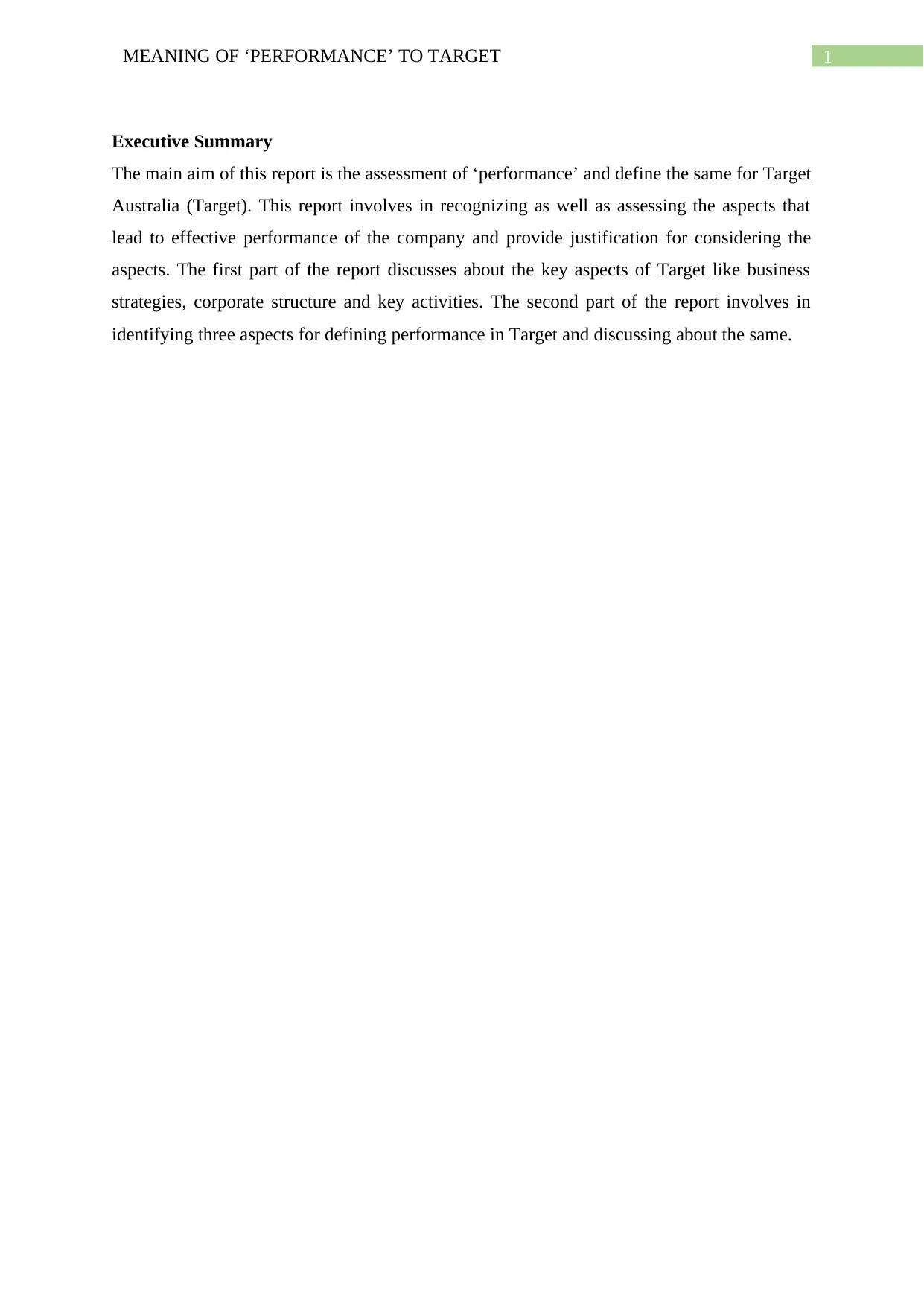
1MEANING OF ‘PERFORMANCE’ TO TARGET
Executive Summary
The main aim of this report is the assessment of ‘performance’ and define the same for Target
Australia (Target). This report involves in recognizing as well as assessing the aspects that
lead to effective performance of the company and provide justification for considering the
aspects. The first part of the report discusses about the key aspects of Target like business
strategies, corporate structure and key activities. The second part of the report involves in
identifying three aspects for defining performance in Target and discussing about the same.
Executive Summary
The main aim of this report is the assessment of ‘performance’ and define the same for Target
Australia (Target). This report involves in recognizing as well as assessing the aspects that
lead to effective performance of the company and provide justification for considering the
aspects. The first part of the report discusses about the key aspects of Target like business
strategies, corporate structure and key activities. The second part of the report involves in
identifying three aspects for defining performance in Target and discussing about the same.
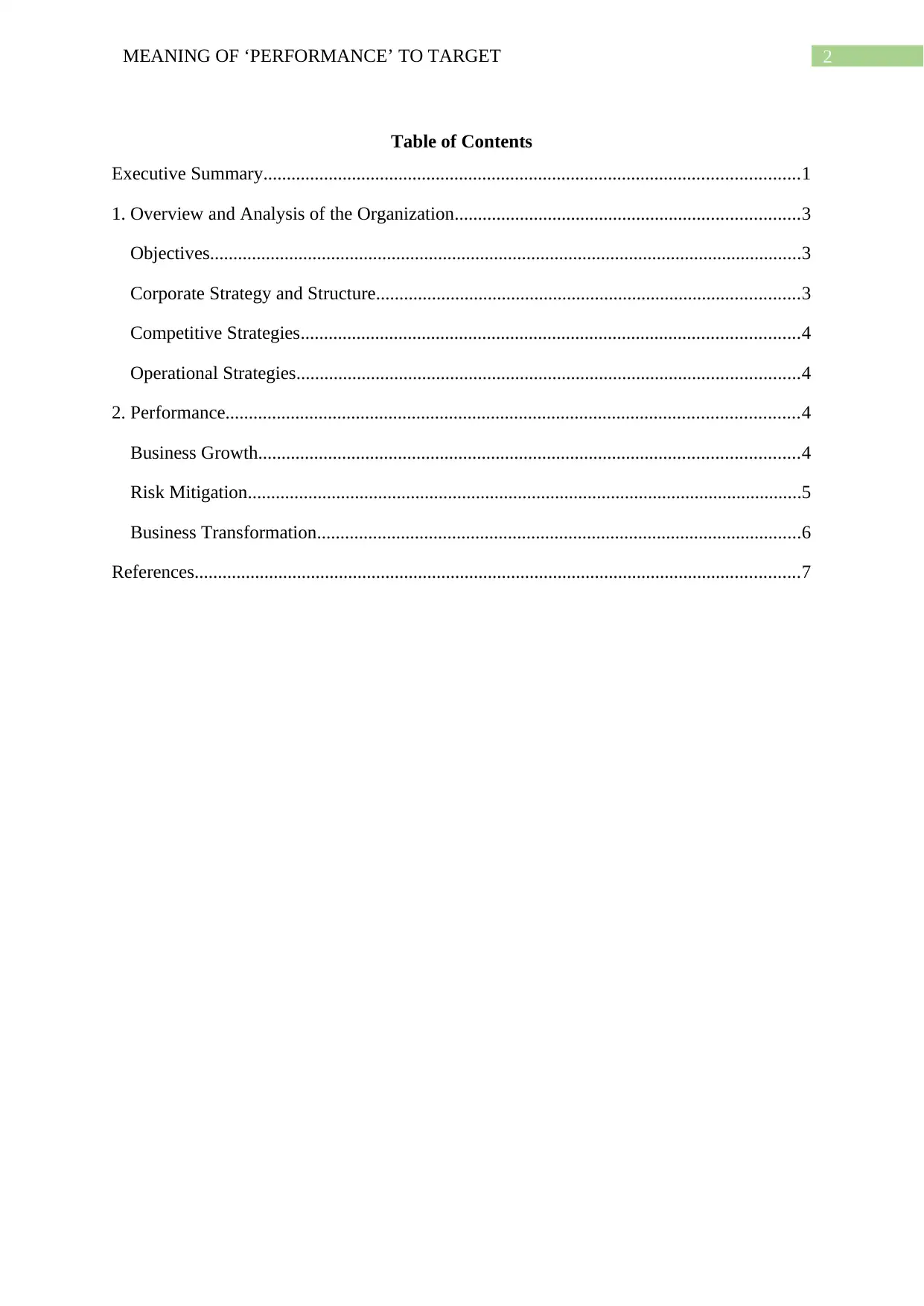
2MEANING OF ‘PERFORMANCE’ TO TARGET
Table of Contents
Executive Summary...................................................................................................................1
1. Overview and Analysis of the Organization..........................................................................3
Objectives...............................................................................................................................3
Corporate Strategy and Structure...........................................................................................3
Competitive Strategies...........................................................................................................4
Operational Strategies............................................................................................................4
2. Performance...........................................................................................................................4
Business Growth....................................................................................................................4
Risk Mitigation.......................................................................................................................5
Business Transformation........................................................................................................6
References..................................................................................................................................7
Table of Contents
Executive Summary...................................................................................................................1
1. Overview and Analysis of the Organization..........................................................................3
Objectives...............................................................................................................................3
Corporate Strategy and Structure...........................................................................................3
Competitive Strategies...........................................................................................................4
Operational Strategies............................................................................................................4
2. Performance...........................................................................................................................4
Business Growth....................................................................................................................4
Risk Mitigation.......................................................................................................................5
Business Transformation........................................................................................................6
References..................................................................................................................................7
⊘ This is a preview!⊘
Do you want full access?
Subscribe today to unlock all pages.

Trusted by 1+ million students worldwide
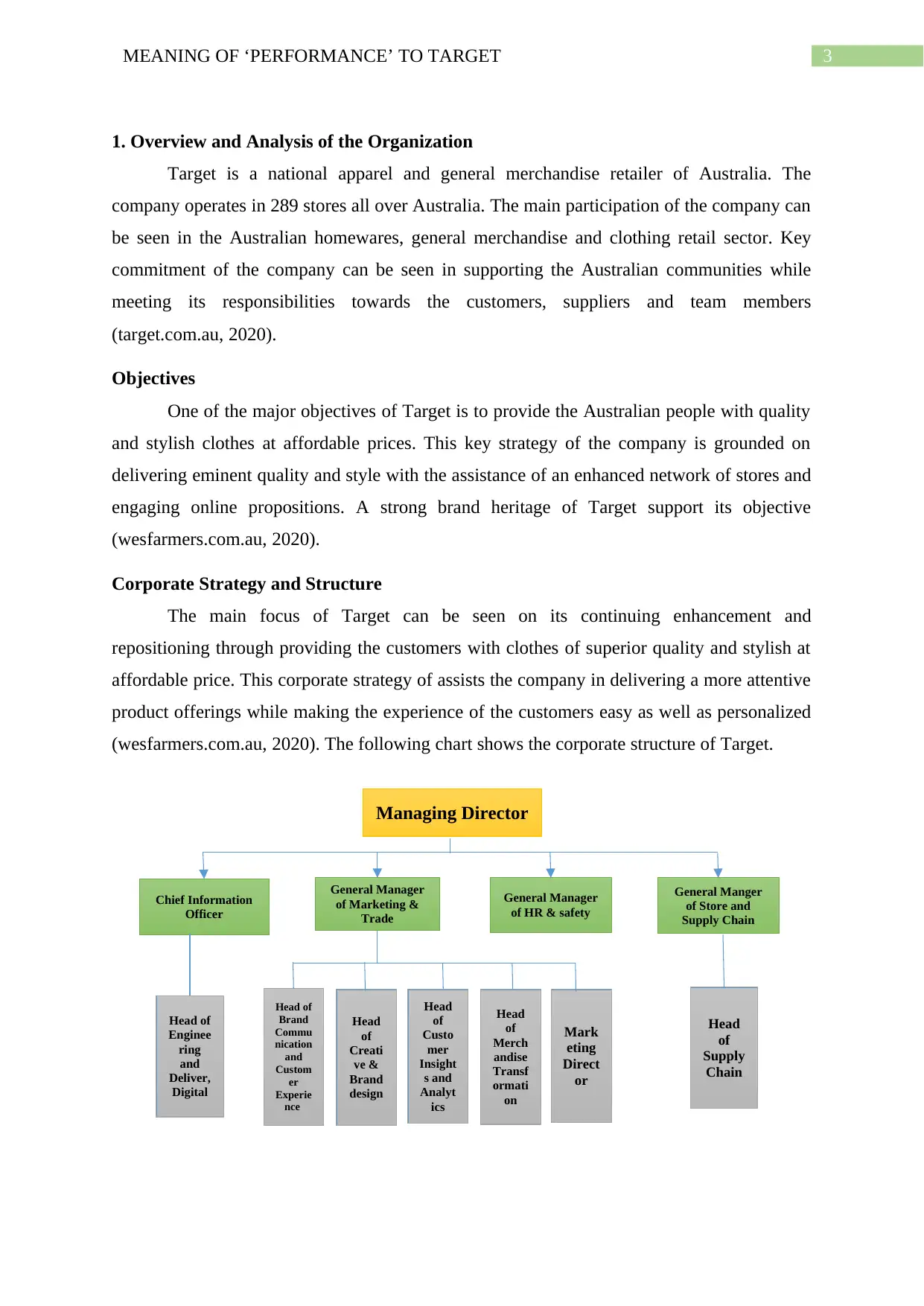
3MEANING OF ‘PERFORMANCE’ TO TARGET
Managing Director
Chief Information
Officer
General Manager
of Marketing &
Trade
General Manager
of HR & safety
General Manger
of Store and
Supply Chain
Head of
Enginee
ring
and
Deliver,
Digital
Head
of
Supply
Chain
Head of
Brand
Commu
nication
and
Custom
er
Experie
nce
Head
of
Creati
ve &
Brand
design
Head
of
Custo
mer
Insight
s and
Analyt
ics
Head
of
Merch
andise
Transf
ormati
on
Mark
eting
Direct
or
1. Overview and Analysis of the Organization
Target is a national apparel and general merchandise retailer of Australia. The
company operates in 289 stores all over Australia. The main participation of the company can
be seen in the Australian homewares, general merchandise and clothing retail sector. Key
commitment of the company can be seen in supporting the Australian communities while
meeting its responsibilities towards the customers, suppliers and team members
(target.com.au, 2020).
Objectives
One of the major objectives of Target is to provide the Australian people with quality
and stylish clothes at affordable prices. This key strategy of the company is grounded on
delivering eminent quality and style with the assistance of an enhanced network of stores and
engaging online propositions. A strong brand heritage of Target support its objective
(wesfarmers.com.au, 2020).
Corporate Strategy and Structure
The main focus of Target can be seen on its continuing enhancement and
repositioning through providing the customers with clothes of superior quality and stylish at
affordable price. This corporate strategy of assists the company in delivering a more attentive
product offerings while making the experience of the customers easy as well as personalized
(wesfarmers.com.au, 2020). The following chart shows the corporate structure of Target.
Managing Director
Chief Information
Officer
General Manager
of Marketing &
Trade
General Manager
of HR & safety
General Manger
of Store and
Supply Chain
Head of
Enginee
ring
and
Deliver,
Digital
Head
of
Supply
Chain
Head of
Brand
Commu
nication
and
Custom
er
Experie
nce
Head
of
Creati
ve &
Brand
design
Head
of
Custo
mer
Insight
s and
Analyt
ics
Head
of
Merch
andise
Transf
ormati
on
Mark
eting
Direct
or
1. Overview and Analysis of the Organization
Target is a national apparel and general merchandise retailer of Australia. The
company operates in 289 stores all over Australia. The main participation of the company can
be seen in the Australian homewares, general merchandise and clothing retail sector. Key
commitment of the company can be seen in supporting the Australian communities while
meeting its responsibilities towards the customers, suppliers and team members
(target.com.au, 2020).
Objectives
One of the major objectives of Target is to provide the Australian people with quality
and stylish clothes at affordable prices. This key strategy of the company is grounded on
delivering eminent quality and style with the assistance of an enhanced network of stores and
engaging online propositions. A strong brand heritage of Target support its objective
(wesfarmers.com.au, 2020).
Corporate Strategy and Structure
The main focus of Target can be seen on its continuing enhancement and
repositioning through providing the customers with clothes of superior quality and stylish at
affordable price. This corporate strategy of assists the company in delivering a more attentive
product offerings while making the experience of the customers easy as well as personalized
(wesfarmers.com.au, 2020). The following chart shows the corporate structure of Target.
Paraphrase This Document
Need a fresh take? Get an instant paraphrase of this document with our AI Paraphraser
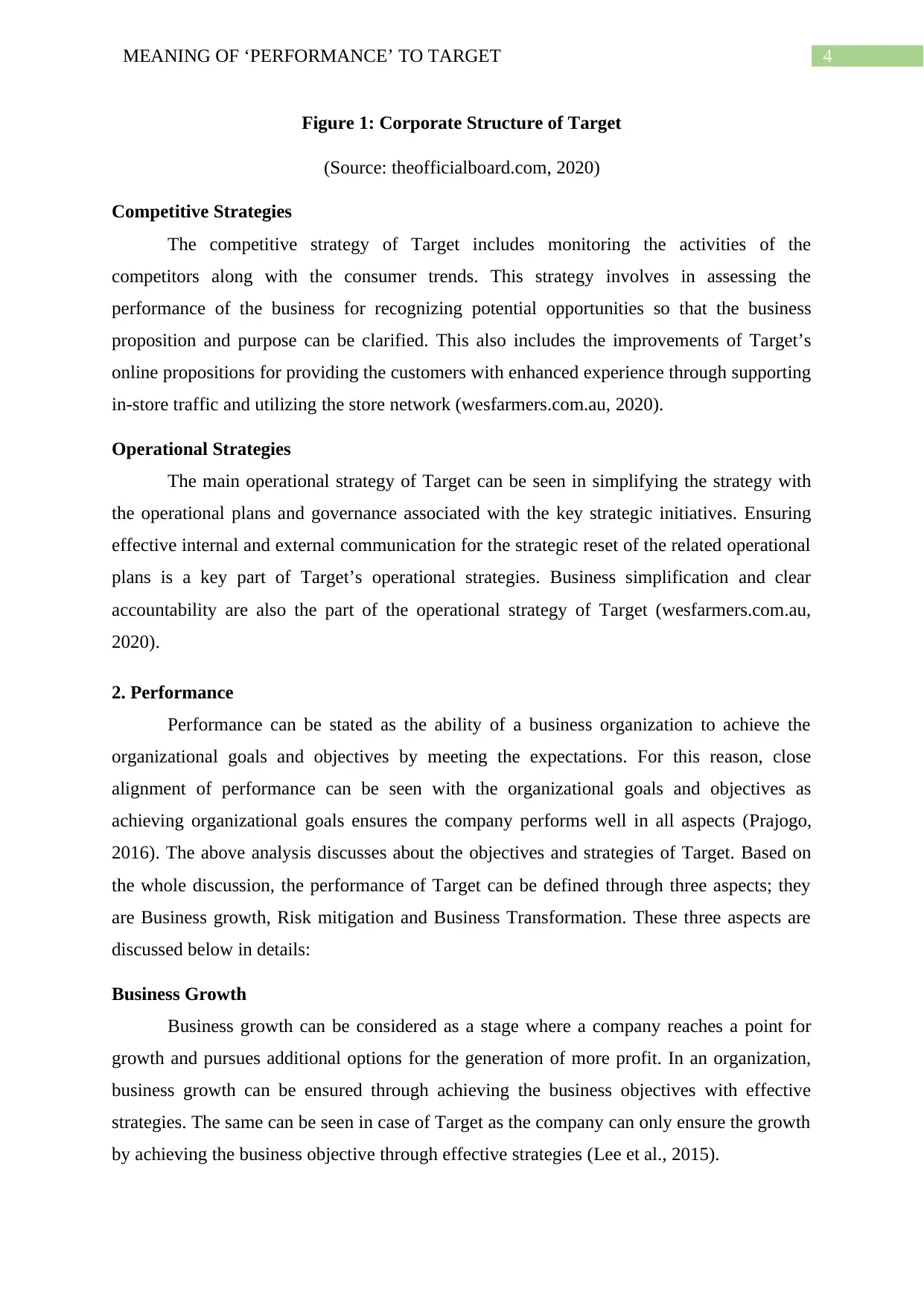
4MEANING OF ‘PERFORMANCE’ TO TARGET
Figure 1: Corporate Structure of Target
(Source: theofficialboard.com, 2020)
Competitive Strategies
The competitive strategy of Target includes monitoring the activities of the
competitors along with the consumer trends. This strategy involves in assessing the
performance of the business for recognizing potential opportunities so that the business
proposition and purpose can be clarified. This also includes the improvements of Target’s
online propositions for providing the customers with enhanced experience through supporting
in-store traffic and utilizing the store network (wesfarmers.com.au, 2020).
Operational Strategies
The main operational strategy of Target can be seen in simplifying the strategy with
the operational plans and governance associated with the key strategic initiatives. Ensuring
effective internal and external communication for the strategic reset of the related operational
plans is a key part of Target’s operational strategies. Business simplification and clear
accountability are also the part of the operational strategy of Target (wesfarmers.com.au,
2020).
2. Performance
Performance can be stated as the ability of a business organization to achieve the
organizational goals and objectives by meeting the expectations. For this reason, close
alignment of performance can be seen with the organizational goals and objectives as
achieving organizational goals ensures the company performs well in all aspects (Prajogo,
2016). The above analysis discusses about the objectives and strategies of Target. Based on
the whole discussion, the performance of Target can be defined through three aspects; they
are Business growth, Risk mitigation and Business Transformation. These three aspects are
discussed below in details:
Business Growth
Business growth can be considered as a stage where a company reaches a point for
growth and pursues additional options for the generation of more profit. In an organization,
business growth can be ensured through achieving the business objectives with effective
strategies. The same can be seen in case of Target as the company can only ensure the growth
by achieving the business objective through effective strategies (Lee et al., 2015).
Figure 1: Corporate Structure of Target
(Source: theofficialboard.com, 2020)
Competitive Strategies
The competitive strategy of Target includes monitoring the activities of the
competitors along with the consumer trends. This strategy involves in assessing the
performance of the business for recognizing potential opportunities so that the business
proposition and purpose can be clarified. This also includes the improvements of Target’s
online propositions for providing the customers with enhanced experience through supporting
in-store traffic and utilizing the store network (wesfarmers.com.au, 2020).
Operational Strategies
The main operational strategy of Target can be seen in simplifying the strategy with
the operational plans and governance associated with the key strategic initiatives. Ensuring
effective internal and external communication for the strategic reset of the related operational
plans is a key part of Target’s operational strategies. Business simplification and clear
accountability are also the part of the operational strategy of Target (wesfarmers.com.au,
2020).
2. Performance
Performance can be stated as the ability of a business organization to achieve the
organizational goals and objectives by meeting the expectations. For this reason, close
alignment of performance can be seen with the organizational goals and objectives as
achieving organizational goals ensures the company performs well in all aspects (Prajogo,
2016). The above analysis discusses about the objectives and strategies of Target. Based on
the whole discussion, the performance of Target can be defined through three aspects; they
are Business growth, Risk mitigation and Business Transformation. These three aspects are
discussed below in details:
Business Growth
Business growth can be considered as a stage where a company reaches a point for
growth and pursues additional options for the generation of more profit. In an organization,
business growth can be ensured through achieving the business objectives with effective
strategies. The same can be seen in case of Target as the company can only ensure the growth
by achieving the business objective through effective strategies (Lee et al., 2015).
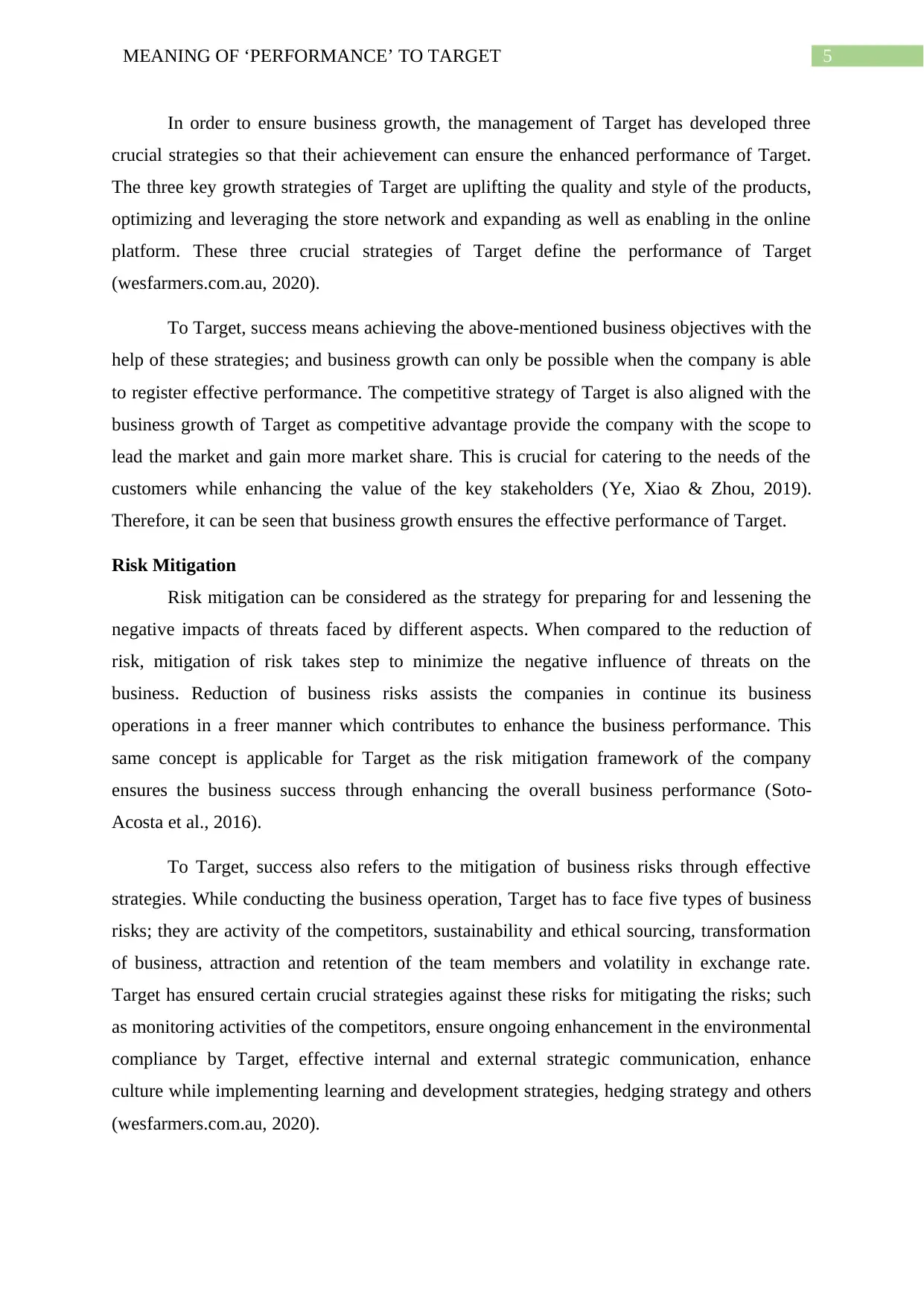
5MEANING OF ‘PERFORMANCE’ TO TARGET
In order to ensure business growth, the management of Target has developed three
crucial strategies so that their achievement can ensure the enhanced performance of Target.
The three key growth strategies of Target are uplifting the quality and style of the products,
optimizing and leveraging the store network and expanding as well as enabling in the online
platform. These three crucial strategies of Target define the performance of Target
(wesfarmers.com.au, 2020).
To Target, success means achieving the above-mentioned business objectives with the
help of these strategies; and business growth can only be possible when the company is able
to register effective performance. The competitive strategy of Target is also aligned with the
business growth of Target as competitive advantage provide the company with the scope to
lead the market and gain more market share. This is crucial for catering to the needs of the
customers while enhancing the value of the key stakeholders (Ye, Xiao & Zhou, 2019).
Therefore, it can be seen that business growth ensures the effective performance of Target.
Risk Mitigation
Risk mitigation can be considered as the strategy for preparing for and lessening the
negative impacts of threats faced by different aspects. When compared to the reduction of
risk, mitigation of risk takes step to minimize the negative influence of threats on the
business. Reduction of business risks assists the companies in continue its business
operations in a freer manner which contributes to enhance the business performance. This
same concept is applicable for Target as the risk mitigation framework of the company
ensures the business success through enhancing the overall business performance (Soto-
Acosta et al., 2016).
To Target, success also refers to the mitigation of business risks through effective
strategies. While conducting the business operation, Target has to face five types of business
risks; they are activity of the competitors, sustainability and ethical sourcing, transformation
of business, attraction and retention of the team members and volatility in exchange rate.
Target has ensured certain crucial strategies against these risks for mitigating the risks; such
as monitoring activities of the competitors, ensure ongoing enhancement in the environmental
compliance by Target, effective internal and external strategic communication, enhance
culture while implementing learning and development strategies, hedging strategy and others
(wesfarmers.com.au, 2020).
In order to ensure business growth, the management of Target has developed three
crucial strategies so that their achievement can ensure the enhanced performance of Target.
The three key growth strategies of Target are uplifting the quality and style of the products,
optimizing and leveraging the store network and expanding as well as enabling in the online
platform. These three crucial strategies of Target define the performance of Target
(wesfarmers.com.au, 2020).
To Target, success means achieving the above-mentioned business objectives with the
help of these strategies; and business growth can only be possible when the company is able
to register effective performance. The competitive strategy of Target is also aligned with the
business growth of Target as competitive advantage provide the company with the scope to
lead the market and gain more market share. This is crucial for catering to the needs of the
customers while enhancing the value of the key stakeholders (Ye, Xiao & Zhou, 2019).
Therefore, it can be seen that business growth ensures the effective performance of Target.
Risk Mitigation
Risk mitigation can be considered as the strategy for preparing for and lessening the
negative impacts of threats faced by different aspects. When compared to the reduction of
risk, mitigation of risk takes step to minimize the negative influence of threats on the
business. Reduction of business risks assists the companies in continue its business
operations in a freer manner which contributes to enhance the business performance. This
same concept is applicable for Target as the risk mitigation framework of the company
ensures the business success through enhancing the overall business performance (Soto-
Acosta et al., 2016).
To Target, success also refers to the mitigation of business risks through effective
strategies. While conducting the business operation, Target has to face five types of business
risks; they are activity of the competitors, sustainability and ethical sourcing, transformation
of business, attraction and retention of the team members and volatility in exchange rate.
Target has ensured certain crucial strategies against these risks for mitigating the risks; such
as monitoring activities of the competitors, ensure ongoing enhancement in the environmental
compliance by Target, effective internal and external strategic communication, enhance
culture while implementing learning and development strategies, hedging strategy and others
(wesfarmers.com.au, 2020).
⊘ This is a preview!⊘
Do you want full access?
Subscribe today to unlock all pages.

Trusted by 1+ million students worldwide
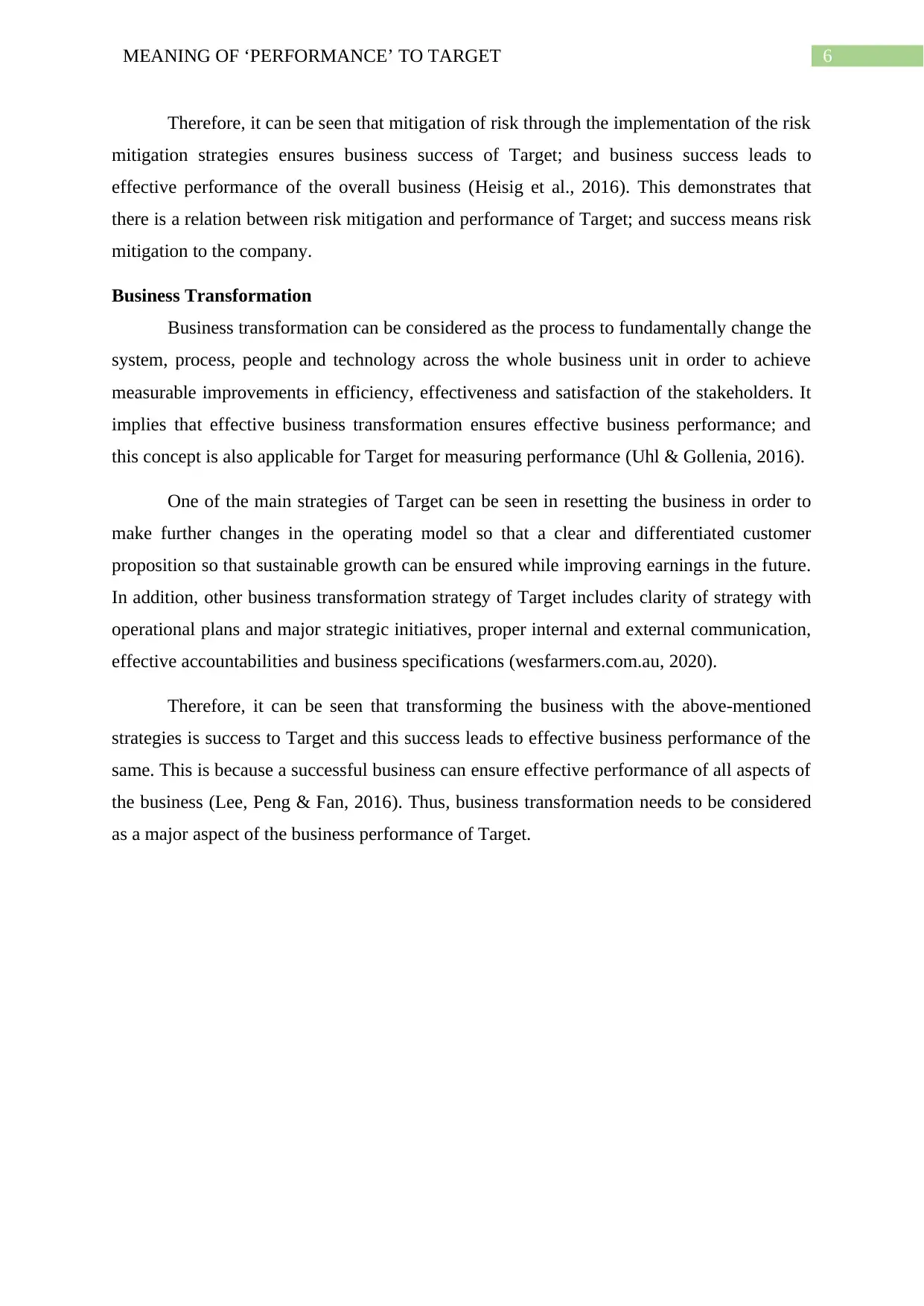
6MEANING OF ‘PERFORMANCE’ TO TARGET
Therefore, it can be seen that mitigation of risk through the implementation of the risk
mitigation strategies ensures business success of Target; and business success leads to
effective performance of the overall business (Heisig et al., 2016). This demonstrates that
there is a relation between risk mitigation and performance of Target; and success means risk
mitigation to the company.
Business Transformation
Business transformation can be considered as the process to fundamentally change the
system, process, people and technology across the whole business unit in order to achieve
measurable improvements in efficiency, effectiveness and satisfaction of the stakeholders. It
implies that effective business transformation ensures effective business performance; and
this concept is also applicable for Target for measuring performance (Uhl & Gollenia, 2016).
One of the main strategies of Target can be seen in resetting the business in order to
make further changes in the operating model so that a clear and differentiated customer
proposition so that sustainable growth can be ensured while improving earnings in the future.
In addition, other business transformation strategy of Target includes clarity of strategy with
operational plans and major strategic initiatives, proper internal and external communication,
effective accountabilities and business specifications (wesfarmers.com.au, 2020).
Therefore, it can be seen that transforming the business with the above-mentioned
strategies is success to Target and this success leads to effective business performance of the
same. This is because a successful business can ensure effective performance of all aspects of
the business (Lee, Peng & Fan, 2016). Thus, business transformation needs to be considered
as a major aspect of the business performance of Target.
Therefore, it can be seen that mitigation of risk through the implementation of the risk
mitigation strategies ensures business success of Target; and business success leads to
effective performance of the overall business (Heisig et al., 2016). This demonstrates that
there is a relation between risk mitigation and performance of Target; and success means risk
mitigation to the company.
Business Transformation
Business transformation can be considered as the process to fundamentally change the
system, process, people and technology across the whole business unit in order to achieve
measurable improvements in efficiency, effectiveness and satisfaction of the stakeholders. It
implies that effective business transformation ensures effective business performance; and
this concept is also applicable for Target for measuring performance (Uhl & Gollenia, 2016).
One of the main strategies of Target can be seen in resetting the business in order to
make further changes in the operating model so that a clear and differentiated customer
proposition so that sustainable growth can be ensured while improving earnings in the future.
In addition, other business transformation strategy of Target includes clarity of strategy with
operational plans and major strategic initiatives, proper internal and external communication,
effective accountabilities and business specifications (wesfarmers.com.au, 2020).
Therefore, it can be seen that transforming the business with the above-mentioned
strategies is success to Target and this success leads to effective business performance of the
same. This is because a successful business can ensure effective performance of all aspects of
the business (Lee, Peng & Fan, 2016). Thus, business transformation needs to be considered
as a major aspect of the business performance of Target.
Paraphrase This Document
Need a fresh take? Get an instant paraphrase of this document with our AI Paraphraser
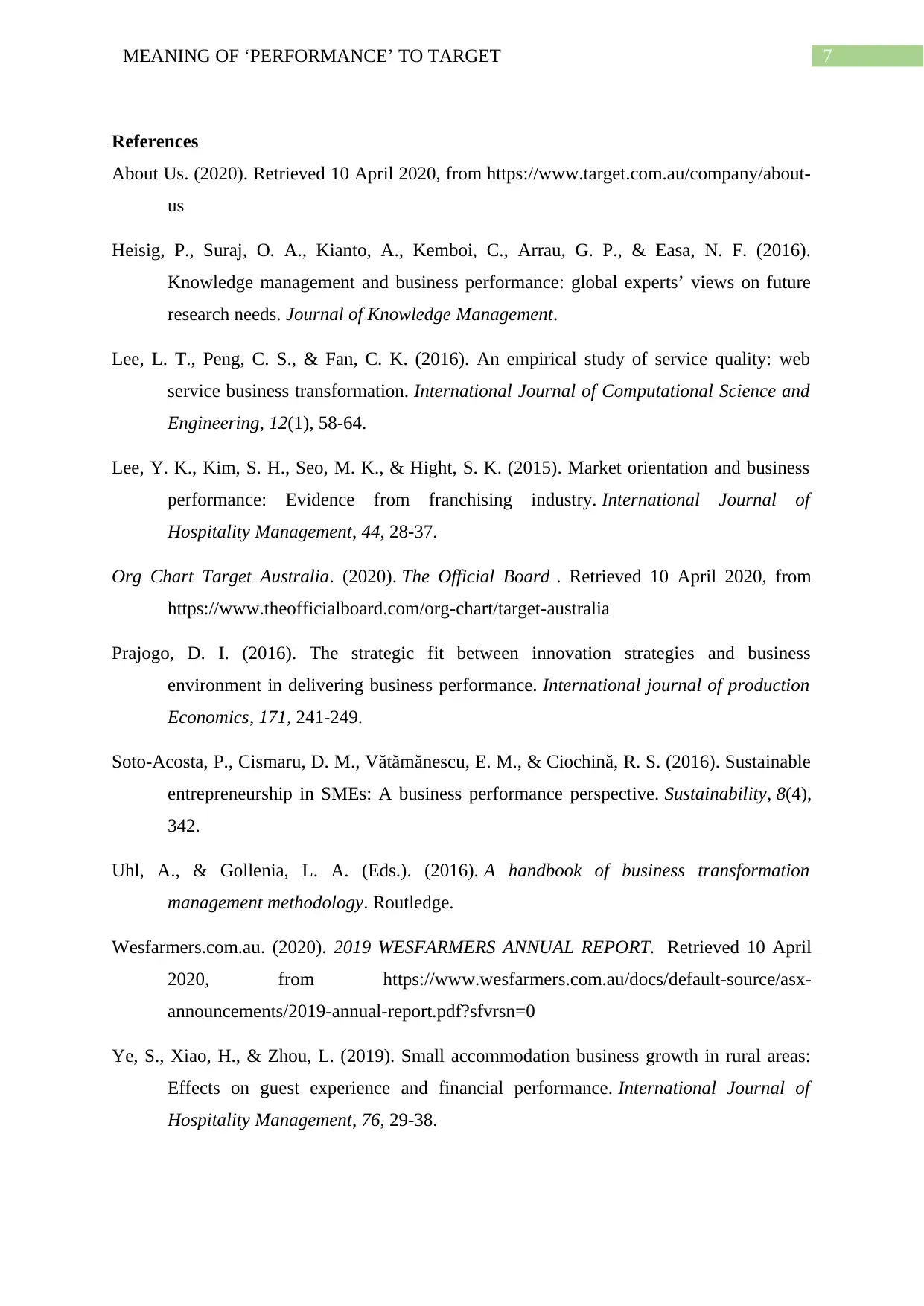
7MEANING OF ‘PERFORMANCE’ TO TARGET
References
About Us. (2020). Retrieved 10 April 2020, from https://www.target.com.au/company/about-
us
Heisig, P., Suraj, O. A., Kianto, A., Kemboi, C., Arrau, G. P., & Easa, N. F. (2016).
Knowledge management and business performance: global experts’ views on future
research needs. Journal of Knowledge Management.
Lee, L. T., Peng, C. S., & Fan, C. K. (2016). An empirical study of service quality: web
service business transformation. International Journal of Computational Science and
Engineering, 12(1), 58-64.
Lee, Y. K., Kim, S. H., Seo, M. K., & Hight, S. K. (2015). Market orientation and business
performance: Evidence from franchising industry. International Journal of
Hospitality Management, 44, 28-37.
Org Chart Target Australia. (2020). The Official Board . Retrieved 10 April 2020, from
https://www.theofficialboard.com/org-chart/target-australia
Prajogo, D. I. (2016). The strategic fit between innovation strategies and business
environment in delivering business performance. International journal of production
Economics, 171, 241-249.
Soto-Acosta, P., Cismaru, D. M., Vătămănescu, E. M., & Ciochină, R. S. (2016). Sustainable
entrepreneurship in SMEs: A business performance perspective. Sustainability, 8(4),
342.
Uhl, A., & Gollenia, L. A. (Eds.). (2016). A handbook of business transformation
management methodology. Routledge.
Wesfarmers.com.au. (2020). 2019 WESFARMERS ANNUAL REPORT. Retrieved 10 April
2020, from https://www.wesfarmers.com.au/docs/default-source/asx-
announcements/2019-annual-report.pdf?sfvrsn=0
Ye, S., Xiao, H., & Zhou, L. (2019). Small accommodation business growth in rural areas:
Effects on guest experience and financial performance. International Journal of
Hospitality Management, 76, 29-38.
References
About Us. (2020). Retrieved 10 April 2020, from https://www.target.com.au/company/about-
us
Heisig, P., Suraj, O. A., Kianto, A., Kemboi, C., Arrau, G. P., & Easa, N. F. (2016).
Knowledge management and business performance: global experts’ views on future
research needs. Journal of Knowledge Management.
Lee, L. T., Peng, C. S., & Fan, C. K. (2016). An empirical study of service quality: web
service business transformation. International Journal of Computational Science and
Engineering, 12(1), 58-64.
Lee, Y. K., Kim, S. H., Seo, M. K., & Hight, S. K. (2015). Market orientation and business
performance: Evidence from franchising industry. International Journal of
Hospitality Management, 44, 28-37.
Org Chart Target Australia. (2020). The Official Board . Retrieved 10 April 2020, from
https://www.theofficialboard.com/org-chart/target-australia
Prajogo, D. I. (2016). The strategic fit between innovation strategies and business
environment in delivering business performance. International journal of production
Economics, 171, 241-249.
Soto-Acosta, P., Cismaru, D. M., Vătămănescu, E. M., & Ciochină, R. S. (2016). Sustainable
entrepreneurship in SMEs: A business performance perspective. Sustainability, 8(4),
342.
Uhl, A., & Gollenia, L. A. (Eds.). (2016). A handbook of business transformation
management methodology. Routledge.
Wesfarmers.com.au. (2020). 2019 WESFARMERS ANNUAL REPORT. Retrieved 10 April
2020, from https://www.wesfarmers.com.au/docs/default-source/asx-
announcements/2019-annual-report.pdf?sfvrsn=0
Ye, S., Xiao, H., & Zhou, L. (2019). Small accommodation business growth in rural areas:
Effects on guest experience and financial performance. International Journal of
Hospitality Management, 76, 29-38.
1 out of 8
Related Documents
Your All-in-One AI-Powered Toolkit for Academic Success.
+13062052269
info@desklib.com
Available 24*7 on WhatsApp / Email
![[object Object]](/_next/static/media/star-bottom.7253800d.svg)
Unlock your academic potential
Copyright © 2020–2025 A2Z Services. All Rights Reserved. Developed and managed by ZUCOL.




